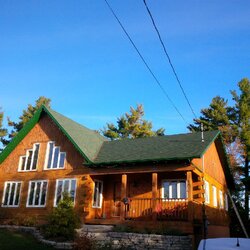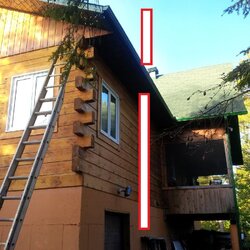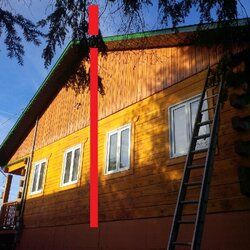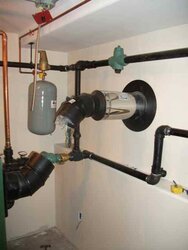Hello all,
I've been reading this site for years while putting together a long-term plan to change our house over from electric baseboard and a high efficiency wood insert fireplace to in-floor radiant and an indoor gasifier boiler with storage. I've read nearly every thread on the subject and I think I've settled on a Vedolux with a built-in fan, although the final size of the unit is still up for some debate (37 or 55). Since the unit will be in the basement, the pull-through design seems like a good idea, and Dean at Smokeless Heat has been a great resource.
We are hoping to do the install in stages to make it less of a shock to the pocketbook. The plan for this year is to install the chimney (6" CSA B-629, 2 inch insulated, through the foundation and up the side of the house) with a temporary wood stove, and prep the storage tank area, then install the Pex, and next year install the tanks and the boiler (and pull out the wood stove). We are in Canada and the dollar has tanked in the last year, and I am hoping it rebounds a bit before we have to buy the unit (it could work out to a couple thousand bucks with the tanks)
My question relates to the location of the chimney install. The basement is drywalled with bare concrete floors and has a walk-out garage door. There are two possible locations for the boiler/chimney. One seems to be a better fit for the interior space we have, one I believe is better for the chimney. I am wondering if there are any opinions or insight as to what will perform better. I am not sure if the draft matters much since the Vedos we are looking at have a draft fan, but we would like to use the chimney temporarily with an EPA wood stove, to cut down on electricity use, until we install the boiler.
Here is a photo of the house that shows the roof line. The chimney will either be on the back wall of the right section of the house, or the right side wall (see pictures below)


This is the back wall install. It would put the boiler in a great spot in the basement. The roof is a 6/12 pitch so I would be looking at 8 feet stickout, maybe more, but this would not extend beyond the roof lines of the house (I would get my 10 feet in all directions with 8 feet). I am worried abut poor draft in this location, and damage to the chimney due to the long stickout. Any opinions? This is the "wife preferred" location as well...

This is the side wall install. I would only need 4 feet stickout to get my distances, and the chimney would be much more protected, but it puts the boiler in the middle of the basement (which is a home workshop) and the chimney is much more visible. I think this location would be better for a draft but it is less practical.
In both cases, I end up with a fair length of chimney, around 24 feet or 20 feet depending on the option. Going through the house is impossible due to the floor plan.
I know that the chimney style I am installing (through wall 90, no framed chase, cold chimney) will work poorly with the temporary wood stove, but I figure two fires is better than one, at least until we get the boiler set up. My thought is to go for the rear install and put up with temporary poor stove performance, so that the boiler is in the opportune spot in the future... But I wanted to make sure that the rear chimney is not an issue for the boiler as well...
I should also mention that we are on top of a hill and get a lot of wind, draft has never been an issue with our insert (a 70,000 BTU Nordica Everest).
Thanks for any input!
Quebexico - Hailing from West Quebec.
I've been reading this site for years while putting together a long-term plan to change our house over from electric baseboard and a high efficiency wood insert fireplace to in-floor radiant and an indoor gasifier boiler with storage. I've read nearly every thread on the subject and I think I've settled on a Vedolux with a built-in fan, although the final size of the unit is still up for some debate (37 or 55). Since the unit will be in the basement, the pull-through design seems like a good idea, and Dean at Smokeless Heat has been a great resource.
We are hoping to do the install in stages to make it less of a shock to the pocketbook. The plan for this year is to install the chimney (6" CSA B-629, 2 inch insulated, through the foundation and up the side of the house) with a temporary wood stove, and prep the storage tank area, then install the Pex, and next year install the tanks and the boiler (and pull out the wood stove). We are in Canada and the dollar has tanked in the last year, and I am hoping it rebounds a bit before we have to buy the unit (it could work out to a couple thousand bucks with the tanks)
My question relates to the location of the chimney install. The basement is drywalled with bare concrete floors and has a walk-out garage door. There are two possible locations for the boiler/chimney. One seems to be a better fit for the interior space we have, one I believe is better for the chimney. I am wondering if there are any opinions or insight as to what will perform better. I am not sure if the draft matters much since the Vedos we are looking at have a draft fan, but we would like to use the chimney temporarily with an EPA wood stove, to cut down on electricity use, until we install the boiler.
Here is a photo of the house that shows the roof line. The chimney will either be on the back wall of the right section of the house, or the right side wall (see pictures below)


This is the back wall install. It would put the boiler in a great spot in the basement. The roof is a 6/12 pitch so I would be looking at 8 feet stickout, maybe more, but this would not extend beyond the roof lines of the house (I would get my 10 feet in all directions with 8 feet). I am worried abut poor draft in this location, and damage to the chimney due to the long stickout. Any opinions? This is the "wife preferred" location as well...

This is the side wall install. I would only need 4 feet stickout to get my distances, and the chimney would be much more protected, but it puts the boiler in the middle of the basement (which is a home workshop) and the chimney is much more visible. I think this location would be better for a draft but it is less practical.
In both cases, I end up with a fair length of chimney, around 24 feet or 20 feet depending on the option. Going through the house is impossible due to the floor plan.
I know that the chimney style I am installing (through wall 90, no framed chase, cold chimney) will work poorly with the temporary wood stove, but I figure two fires is better than one, at least until we get the boiler set up. My thought is to go for the rear install and put up with temporary poor stove performance, so that the boiler is in the opportune spot in the future... But I wanted to make sure that the rear chimney is not an issue for the boiler as well...
I should also mention that we are on top of a hill and get a lot of wind, draft has never been an issue with our insert (a 70,000 BTU Nordica Everest).
Thanks for any input!
Quebexico - Hailing from West Quebec.






